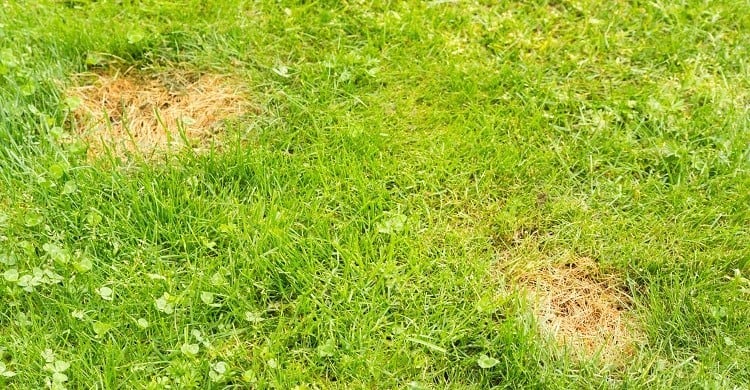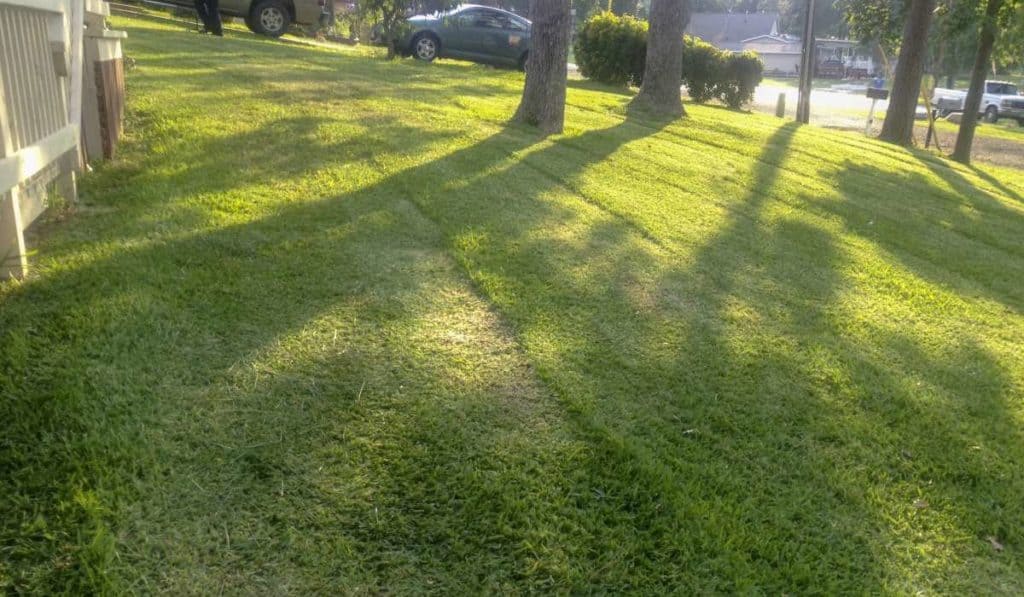Having lush, green grass in your front yard takes hard work and patience. When you are diligent about your lawn care practices, it can be frustrating to see parts of the grass turning yellow. So, why does your lawn have yellow lines, and how can you fix it?
Your lawn has yellow lines because of overfertilization, over/underwatering, nutritional deficiency, lawn disease, pet urine, or improper use of a mower. To fix these issues, you’ll need to adjust your maintenance routine to ensure your lawn is getting what it needs to thrive.
In this article, I’ll explain where those yellow lines are coming from, and share some helpful tips to restore your lawn and get it looking healthy again.
Why Your Lawn Has Yellow Lines
A common misconception is that yellow grass always means it needs more water. Although this is one of the possible reasons, there are other likely culprits. Before you can begin to resolve the issue, you need to find the underlying cause of your lawn’s affliction.
Overfertilization and Fertilization Misses
Although fertilizer is meant to boost your lawn’s health, too much of it can cause more harm than good. Heavy fertilization introduces high nitrogen salts, which burn the grass and result in a yellow color.
This happens especially when using synthetic fertilizers. Other signs of overfertilization in your lawn are:
- Slow grass growth
- Brown parts of the grass blade
- A crust of fertilizer on the soil
Fertilizer misses are another potential cause of yellow lines in your lawn. A fertilizer miss means that the fertilizer granules miss some parts of the lawn. In this case, the parts that get adequate fertilizer green-up while those that miss the fertilizer become light green or yellow. Check out my article here about how to fertilize with a seed spreader.
Overwatering or Underwatering
Too much water on the lawn causes water logging and poor development of grass. Due to waterlogging, the grassroots become shallow, making it impossible to absorb oxygen, water, and nutrients. The excess water makes the lawn prone to insect infestation, weeds, and fungal diseases.
Inadequate water can also lead to discoloration. To ensure that your lawn is getting enough water, you must consider the time of day that you are watering the grass. If you are watering the lawn when the sun is too hot, you risk losing a significant amount of water to evaporation.
If you are using a sprinkler, or have a sprinkler system, make sure that it is not missing any parts of the lawn. When you have gaps in your watering, it can result in the yellowing of your lawn.
Nutritional Deficiency
Nutritional deficiencies can have several effects on the lawn that present in different ways, including yellow lines or discoloration. Iron and nitrogen are the most common nutritional deficiencies that cause yellow parts.
Here is an article about 17 fertilizers high in nitrogen that I’ve written.
Lawn Diseases
The presence of fungus on your lawn leads to diseases like snow mold, smut, fairy ring, and fusarium. Most of these diseases manifest as yellow lines or patches on the lawn. Other lawn diseases may be caused by pests and insects.
Pets Urine
Do your pets spend time in your yard? Their urine may be the reason for the discoloration on your lawn! Pets urine, especially a dog’s urine, is rich in a high concentration of nitrogen. When this nitrogen gets on your lawn, it burns the grass, causing yellow patches to appear.

Using Improper Mowing Techniques
While mowing is meant to improve the look of your lawn, it’s likely to damage it if done in the wrong way. If you notice yellow lines soon after mowing, you may need to adjust your mowing technique.
Using dull mower blades and cutting off too much grass leads to stress on the lawn. Cutting the grass too short leaves it with inadequate moisture, thus discoloration.
Additionally, if your lawn is stressed and you are using a heavy mower; this can cause stripes.

6 Ways To Fix the Yellow Lines on Your Lawn
Now that you understand the potential reasons behind the yellow lines in your lawn, let’s talk about some tried and true ways to resolve these common issues.
Complete a Soil Test
In order to determine any potential soil nutrient deficiencies, I recommend doing a soil test. This can be done with an at-home test kit. I recommend MySoil Soil Test Kit from Amazon.com because it is easy to use and gives accurate pH analysis with a single use.
Ensure You Apply the Right Amount of Fertilizer
It is crucial to follow the instructions when applying fertilizer. Be sure to apply the precise amount of fertilizer indicated. If you have accidentally over-fertilized, flush water on the lawn to wash away the excess granules.
Water Your Lawn Based on the Weather
Consider the weather when determining your watering schedule. Typically, there is no need to water the lawn during the rainy season. If you live in a warm climate, you will want to make sure you are not watering under direct sunlight. It is a good practice to water either in the early morning or after the sun has gone down to achieve optimum water absorption.
Still not sure how to approach your watering schedule? Here is a helpful YouTube video that explains how to water your lawn the right way:
Use Your Lawn Mower Properly
If you’ve already cut the grass too short, you’ll need to make sure you’re giving it enough water and fertilizer to enable faster growth. Allow time for the grass to grow before mowing again.
When you are ready to mow, raise the grass cutting height to 3 inches (7.62 cm) but no taller than 4 inches (10.16 cm). For further assistance, check out this informative YouTube video full of helpful hints for properly mowing your lawn:
Train Your Dog or Cat To Pee in a Specific Area
If you find that your pet is the yellow-spot offender, you will need to train your dog or cat to eliminate where there is no grass. Additionally, you should hose down any areas where your pet has peed in order to wash away the nitrogen before it burns the grass.
Unfortunately, sometimes it is not your pet that is causing the issue- but a neighbor’s. To prevent the neighborhood dog from turning your grass yellow, place a fence around your yard or talk to your neighbor about finding a resolution.
Hire a Lawn Care Professional
Sometimes maintaining a proper lawn care routine can cause stress and frustration. If you do not have the time or desire to carry out lawn maintenance on your own, hiring a professional can be a great alternative.

